| 19th Dynasty (263) 15180-1317BC | |
| When Horemheb, the last king of XVIII Dynasty, died, apparently childless, Paramessu succeeded him as Ramesses I. Paramessu's family came from Avaris, the former capital of the Hyksos, and the role of its local god Seth, who had retained strong connections with the Canaanite god Ba'al, appears to have been comparable with that of Horus of Hutnesu in Horemheb's career. The Ramessid royal family considered the god Seth to be their royal ancestor, and a fragment of an obelisk, recently discovered on the seabed of the coast of Alexandria, shows Seti I as a sphinx with the head of the Seth-animal offering to Re-Atum. With Ramesses I began a new dynasty, although there is some evidence to suggest that the Ramessid pharaohs considered Horemheb as the true founder of the dynasty. | |
|
Rameses I |
|
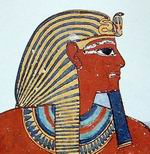 Son
of Swti, the commander of royal archers. He held many weighty
offices in army, he was later vizier and confidant of Horemheb,
appointed by him as heir to the throne. As a vizier he ordered to
build for himself a tomb at Gurob (Fayum Oasis) where also Ramesses’
wife (or relative) was buried. After he had been designated heir to
the throne he built for himself a KV16 tomb in the Kings’ Valley.
The king’s mummy was found in Deir el-Bahari DB320 cache and now is
a property of Atlanta Museum (USA) while fragment of his sarcophagus
can be seen in Kairo Museum. Ramesses I ruled one year and 4 months,
as co-regent with his son and successor, Seti I. Son
of Swti, the commander of royal archers. He held many weighty
offices in army, he was later vizier and confidant of Horemheb,
appointed by him as heir to the throne. As a vizier he ordered to
build for himself a tomb at Gurob (Fayum Oasis) where also Ramesses’
wife (or relative) was buried. After he had been designated heir to
the throne he built for himself a KV16 tomb in the Kings’ Valley.
The king’s mummy was found in Deir el-Bahari DB320 cache and now is
a property of Atlanta Museum (USA) while fragment of his sarcophagus
can be seen in Kairo Museum. Ramesses I ruled one year and 4 months,
as co-regent with his son and successor, Seti I.Other Datings 1315-1314 (Redford) |
|
|
Sethi I |
|
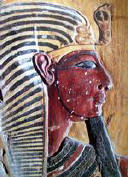 Son
of Ramesses I by Satre. After coming to the rule he was forced to
undertake series of war campaigns to Asia and Libya. He made wars
with Hittites, conquered the land of Amurru and city of Kadesh. In
his 8th regnal year he made war expedition to the land of Jam in
Sudan. History records of his warlike deeds add splendor to walls of
many Egyptian temples. He erected magnificent temple at Abydos and a
number of building structures all over Egypt, among others great
hypostyle of the temple of Karnak, mortuary temples in Western
Thebes and Memphis. He erected temple of Amun at Napata in Nubia, as
well as in other cities. Many temples, destructed during Amarna
period, were restored and covered with new reliefs and polychrome.
He started building new capital of Ramessides in the Delta. Burial
place of the ruler became the finely decorated tomb KV17 in the
Kings’ Valley. The king’s mummy was found in the Deir el-Bahari
cache DB320. Son
of Ramesses I by Satre. After coming to the rule he was forced to
undertake series of war campaigns to Asia and Libya. He made wars
with Hittites, conquered the land of Amurru and city of Kadesh. In
his 8th regnal year he made war expedition to the land of Jam in
Sudan. History records of his warlike deeds add splendor to walls of
many Egyptian temples. He erected magnificent temple at Abydos and a
number of building structures all over Egypt, among others great
hypostyle of the temple of Karnak, mortuary temples in Western
Thebes and Memphis. He erected temple of Amun at Napata in Nubia, as
well as in other cities. Many temples, destructed during Amarna
period, were restored and covered with new reliefs and polychrome.
He started building new capital of Ramessides in the Delta. Burial
place of the ruler became the finely decorated tomb KV17 in the
Kings’ Valley. The king’s mummy was found in the Deir el-Bahari
cache DB320.Other Datings 1314-1304
(Redford) |
|
|
Rameses II |
|
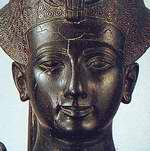 Son
of Seti I by queen Tui. He had 7 legal, royal wives and 200
concubines. Historical sources record that he had 96 sons and 60
daughters. Ramesses II was regarded one of the mightiests (if not
the one mightiest) Egyptian pharaohs. Certainly he is the best known
ruler of ancient Egypt and a symbol of this land. Three facts went
into the making thereof: tremendous building activity, traces of
which can be found all over Egypt; active internal policy and
presence of military force keeping strong position of Egyptian
Empire as well as immensely long rule, comprising 67 years. He was
crowned the king after his father’s death in June 1279 BC. In his
4th regnal year he made first military campaign into Syria which
resulted in relieving of the principality of Amurru ruled by
Betneshina. The next year took place battle at Kadesh by Orontes.
The course of this most famous in Egyptian history battle is
recorded in wall presentations of temples at Abydos, Thebes and Abu
Simbel, also in papyri and is called Poem of Pentewere. Egyptian
sources present the battle as a great triumph of Egyptian army and
pharaoh Ramesses II in person, Hittite sources - in contrary. The
fact that in consequence the land of Amurru had been annexed to
Hittites’ influence zone allows us to conclude that closer to the
truth are Hittite sources which record failure (if not complete
defeat) of Egyptian army. Next over a dozen-or-so years Ramesses was
making numerous war campaigns into Syria-Palestine, consolidating
his own influence zone. Treaty made in 1258 with Hittites warranted
in writing non-aggression and mutual relieving of political
refugees. This is an oldest known historical document made between
two foreign countries. In 1245 and 1240 BC to the royal harem
arrived two Hittite princesses thus consolidating the peace with the
land of Hatti. There are known to us expeditions to land of Jam in
Sudan in year 21 of Ramesses reign and to Nubia in year 44, under
command of Setau, the viceroy of Kush. Ramesses II reinforced
fortresses in the Western Delta which protected from the “sea
people” attacks and Libyan tribes. Building activity of the king
exceeds that of any other pharaoh and counting out at least part of
buildings erected or restored in his times seems to be impossible.
There is no city in Egypt where the ruler would not have left traces
of his building activities. Temples in Western Thebes (Ramesseum)
and Abu Simbel are masterpieces of ancient Egyptian architecture.
Near Tanis (Pe-Ramesu) he completed erecting a capital started by
Seti I. During his 67 years long rule Ramesses II celebrated 14
times Sed festival. Son
of Seti I by queen Tui. He had 7 legal, royal wives and 200
concubines. Historical sources record that he had 96 sons and 60
daughters. Ramesses II was regarded one of the mightiests (if not
the one mightiest) Egyptian pharaohs. Certainly he is the best known
ruler of ancient Egypt and a symbol of this land. Three facts went
into the making thereof: tremendous building activity, traces of
which can be found all over Egypt; active internal policy and
presence of military force keeping strong position of Egyptian
Empire as well as immensely long rule, comprising 67 years. He was
crowned the king after his father’s death in June 1279 BC. In his
4th regnal year he made first military campaign into Syria which
resulted in relieving of the principality of Amurru ruled by
Betneshina. The next year took place battle at Kadesh by Orontes.
The course of this most famous in Egyptian history battle is
recorded in wall presentations of temples at Abydos, Thebes and Abu
Simbel, also in papyri and is called Poem of Pentewere. Egyptian
sources present the battle as a great triumph of Egyptian army and
pharaoh Ramesses II in person, Hittite sources - in contrary. The
fact that in consequence the land of Amurru had been annexed to
Hittites’ influence zone allows us to conclude that closer to the
truth are Hittite sources which record failure (if not complete
defeat) of Egyptian army. Next over a dozen-or-so years Ramesses was
making numerous war campaigns into Syria-Palestine, consolidating
his own influence zone. Treaty made in 1258 with Hittites warranted
in writing non-aggression and mutual relieving of political
refugees. This is an oldest known historical document made between
two foreign countries. In 1245 and 1240 BC to the royal harem
arrived two Hittite princesses thus consolidating the peace with the
land of Hatti. There are known to us expeditions to land of Jam in
Sudan in year 21 of Ramesses reign and to Nubia in year 44, under
command of Setau, the viceroy of Kush. Ramesses II reinforced
fortresses in the Western Delta which protected from the “sea
people” attacks and Libyan tribes. Building activity of the king
exceeds that of any other pharaoh and counting out at least part of
buildings erected or restored in his times seems to be impossible.
There is no city in Egypt where the ruler would not have left traces
of his building activities. Temples in Western Thebes (Ramesseum)
and Abu Simbel are masterpieces of ancient Egyptian architecture.
Near Tanis (Pe-Ramesu) he completed erecting a capital started by
Seti I. During his 67 years long rule Ramesses II celebrated 14
times Sed festival.Burial place of the ruler was tomb KV7, the one of most finely decorated tombs in the Kings’ Valley, unfortunately now is vastly damaged by water and mud. The king’s mummy primarily moved to tomb of Seti I was finally concealed in the Deir el-Bahari cache DB320 and discovered in 1881. In front of his own tomb Ramesses ordered to build huge tomb KV5, discovered in 1995 by K.R. Weeks. It was meant to serve as a collective tomb of numerous sons of Ramesses. Burial place of the king’s first wife, the queen Nefertari, became a tomb QV66 in the Queens’ Valley. Other Datings 1304-1237
(Redford) |
|
|
Merneptah |
|
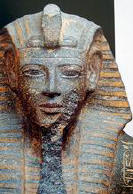 The
thirteenth son of Ramesses II, his mother was queen Isetnofret I. He
ruled as co-regent for 12 years, after holding an office of a
general. Manetho mentions his 19 years and 6 months long rule. This
duration is entirely overestimated unless co-regency with Ramesses
II is considered. The most significant event during Merenptah’s rule
was repulse of Libyans’ and Sea Peoples’ attacks in his year 5.
Presumably he lead also victorious campaign into Asia as recorded in
“stele of Israel”, the only preserved document confirming existence
of this small tribe in Western Asia, both proudly and untruthfully
described in Bible. Building activity of Merenptah focused mainly in
Western Thebes and Memphis from where mortuary temple erected of
blocks gathered from pulled down Theban temple of Amenhothep III and
palace and sacral complex devoted to Ptah and royal cult should be
mentioned. The
thirteenth son of Ramesses II, his mother was queen Isetnofret I. He
ruled as co-regent for 12 years, after holding an office of a
general. Manetho mentions his 19 years and 6 months long rule. This
duration is entirely overestimated unless co-regency with Ramesses
II is considered. The most significant event during Merenptah’s rule
was repulse of Libyans’ and Sea Peoples’ attacks in his year 5.
Presumably he lead also victorious campaign into Asia as recorded in
“stele of Israel”, the only preserved document confirming existence
of this small tribe in Western Asia, both proudly and untruthfully
described in Bible. Building activity of Merenptah focused mainly in
Western Thebes and Memphis from where mortuary temple erected of
blocks gathered from pulled down Theban temple of Amenhothep III and
palace and sacral complex devoted to Ptah and royal cult should be
mentioned.Burial place – tomb KV8 in the Kings’ Valley. His mummy was found in the KV35 tomb-cache of Amenhotep II Other Datings 1237-1226
(Redford) |
|
|
Sethi II |
|
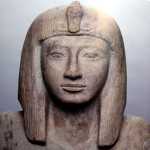 There
is no certainty if he was a son of Merenptah by queen Isetnofret or,
as suggest E.F. Wente and J.R. Harris, he was not related to the
dynasty at all. Assuming that Amenmose was usurper we can conclude
that Amenmose ruled over Thebaida for some time under Seti II’s rule
in Lower Egypt. It is no doubt however that Seti II ordered to
remove decorations from Amenmose’s temple in the Valley of the
Kings. Seti II founded a station for a barge on the courtyard in
front of the pylon II at Karnak, and chapels of Theban triad – Amun,
Mut and Chonsu. He was buried on the day 11, month 3 of the peret
season (winter) in tomb KV15 in the Kings’ Valley. The king’s mummy
was moved to the tomb KV14 of Taweseret in her last year of reign
and after Sethnakht’s ascended a throne returned to its previous
burial place. Finally it was deposed in the KV35 tomb-cache of
Amenhotep II. There
is no certainty if he was a son of Merenptah by queen Isetnofret or,
as suggest E.F. Wente and J.R. Harris, he was not related to the
dynasty at all. Assuming that Amenmose was usurper we can conclude
that Amenmose ruled over Thebaida for some time under Seti II’s rule
in Lower Egypt. It is no doubt however that Seti II ordered to
remove decorations from Amenmose’s temple in the Valley of the
Kings. Seti II founded a station for a barge on the courtyard in
front of the pylon II at Karnak, and chapels of Theban triad – Amun,
Mut and Chonsu. He was buried on the day 11, month 3 of the peret
season (winter) in tomb KV15 in the Kings’ Valley. The king’s mummy
was moved to the tomb KV14 of Taweseret in her last year of reign
and after Sethnakht’s ascended a throne returned to its previous
burial place. Finally it was deposed in the KV35 tomb-cache of
Amenhotep II.Other Datings 1221-1215
(Redford) |
|
|
Septah |
|
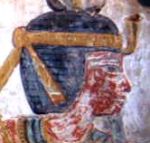 Son
of Seti II by his Syrian concubine. He was changing his titulary
while holding his rule. It should be assumed that he was merely in
his 14 as he inherited the throne because he died aged 20 as
revealed analysis of his mummy. In his behalf the rule was held by
Taweseret, his step-mother. Another interesting figure of those
times was chancellor Bay, usurping the right to the rule. Tomb of
Bay was found in the Valley of the Kings – KV13. Based upon the
Harris’ papyrus Bay is usually identified with “the Syrian of Yarsu”
and died presumably some time before Siptah. Burial place of Siptah
– tomb KV47 on the Kings’ Valley. The king’s mummy was found in the
Amenhotep II KV35 tomb-cache. Son
of Seti II by his Syrian concubine. He was changing his titulary
while holding his rule. It should be assumed that he was merely in
his 14 as he inherited the throne because he died aged 20 as
revealed analysis of his mummy. In his behalf the rule was held by
Taweseret, his step-mother. Another interesting figure of those
times was chancellor Bay, usurping the right to the rule. Tomb of
Bay was found in the Valley of the Kings – KV13. Based upon the
Harris’ papyrus Bay is usually identified with “the Syrian of Yarsu”
and died presumably some time before Siptah. Burial place of Siptah
– tomb KV47 on the Kings’ Valley. The king’s mummy was found in the
Amenhotep II KV35 tomb-cache.Other Datings 1215-1209
(Redford) |
|
|
Twosre |
|
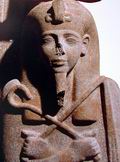 Wife
of Seti II, step-mother of Siptah. As Seti-Merenptah, the son of
Taweseret (or Takhat) and Seti II, who was the legal heir, died
prematurely, the throne was passed to Taweseret’s minor stepson –
Siptah. The queen held rule as regent in his behalf and after death
of 20-years old king she overtook it also formally. She started even
counting length of her reign including years of regency. That’s why
Manetho ascribed to her 7 years of rule. The reason for decline of
Taweseret’s rule was conflict with Sethnakht. Burial place – tomb
KV14 in Kings’ Valley. Wife
of Seti II, step-mother of Siptah. As Seti-Merenptah, the son of
Taweseret (or Takhat) and Seti II, who was the legal heir, died
prematurely, the throne was passed to Taweseret’s minor stepson –
Siptah. The queen held rule as regent in his behalf and after death
of 20-years old king she overtook it also formally. She started even
counting length of her reign including years of regency. That’s why
Manetho ascribed to her 7 years of rule. The reason for decline of
Taweseret’s rule was conflict with Sethnakht. Burial place – tomb
KV14 in Kings’ Valley.
Other Datings 1209-1201 (Redford) |
|